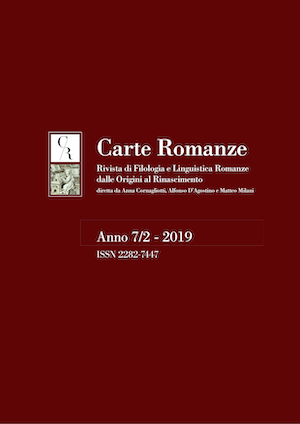Di monaci e abati («Decameron» I 4)
Main Article Content
Abstract
Starting from the study of the novel I 4 of the Decameron (the one in which an abbot forgives the lust of a young monk, because he surprised him committing the same sin), the author identifies, in the Romance literature of the Middle Ages and the Renaissance, two basic narrative models: that of the aforementioned novel ((De l’evesque qui beneï lo con; Novellino, LIV and Decameron I 4 and IX 2); and the one, in some respects similar, in which a holy man mocks the bourgeois or the peasant of whose wife he is the lover (Decameron, III 4, VII 3, IX 10; Sacchetti, Trecentonovelle, 207; Poggio Bracciolini, Liber facetiarum, 203; Masuccio, Novellino, I 3). In both models there may be the motif of the “priest’s breeches”, but in the second it acquires the tones of “mockery” that are missing in the first.
Article Details
Carte Romanze si serve di una licenza  Creative Commons. Attraverso la licenza CC-BY-NC-ND gli autori conservano tutti i diritti economici e concedono alla rivista il diritto non esclusivo di pubblicazione, permettendo a chiunque di scaricare il contributo, di leggerlo e stamparlo. Ogni riuso deve prevedere la citazione virgolettata (o comunque riconoscibile), garantendo all’autore la proprietà intellettuale di quanto citato, e segnalando sempre e comunque la rivista come fonte (con l’indicazione dell’annata, del volume e delle pagine). Non è invece concessa a nessuno la modifica del contributo né il riuso per creare opere secondarie.
Creative Commons. Attraverso la licenza CC-BY-NC-ND gli autori conservano tutti i diritti economici e concedono alla rivista il diritto non esclusivo di pubblicazione, permettendo a chiunque di scaricare il contributo, di leggerlo e stamparlo. Ogni riuso deve prevedere la citazione virgolettata (o comunque riconoscibile), garantendo all’autore la proprietà intellettuale di quanto citato, e segnalando sempre e comunque la rivista come fonte (con l’indicazione dell’annata, del volume e delle pagine). Non è invece concessa a nessuno la modifica del contributo né il riuso per creare opere secondarie.
Quando siano rispettate le indicazioni di cui sopra, non è necessario richiedere ulteriori permessi di utilizzazione del materiale né all’autore né al comitato scientifico.

